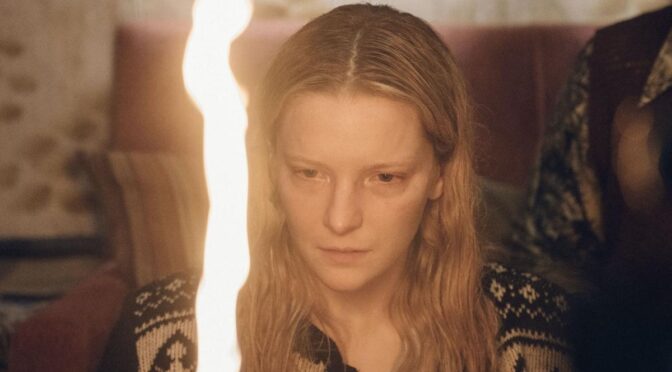STARVE ACRE combines several talents to a deeply unsettling effect. Daniel Kokotajlo’s second feature (based on an Andrew Michael Hurley novel) evokes folk horror released around the film’s 1970s setting, and whilst it doesn’t necessarily plough new ground in tone or theme, some of the vivid imagery makes the film a memorable portrait of grief and the lingering effects of trauma and abuse.
Richard (Matt Smith) and Juliette (Morfydd Clark) live in rural Yorkshire, at the former home of Richard’s parents, where they seek some peace, quiet, and clean air for themselves and their asthmatic son, Owen (Arthur Shaw). An eerie tone is already established by Kokotajlo before disturbing elements of local folklore and superstition start to appear amidst unsettling behaviour from Owen. Tragedy befalls the family, and the ensuing spiral into despair and delusion is punctuated by supernatural imagery and macabre happenings.
After an opening rich in dread, thanks to the score of Matthew Herbert, much of the film focuses on archaeologist Richard uncovering his roots, both metaphorically and literally. A past with his abusive father drives his desire to do better as a parent himself and see the best in his son. As the film colours in that past, much of its focus pivots on the grounds of their country home and the oak tree upon which Richard focuses his grief. The supernatural occurrences associated with this oak tree and their chronicling in folk stories – the subject of bizarre manuscripts and journals written by Richard’s father – bring a grimy tangibility to the more ephemeral concepts of grief and lingering trauma.
“The supernatural occurrences associated with this oak tree and their chronicling in folk stories – the subject of bizarre manuscripts and journals written by Richard’s father – bring a grimy tangibility to the more ephemeral concepts of grief and lingering trauma.”
The characters’ sorrow grips them in such a way that they bring life to their despair, seeking outlets for their now-orphaned instincts as parents and caregivers. The traumas of the past grow flesh and demand their attention, drawing them away from the supportive figures in their present, such as Juliette’s sister, Harrie (Erin Richards). The spectre of generational trauma is present throughout and hard to overlook as Richard quite literally excavates the roots of the oak tree with which his father was obsessed whilst poring over the images and writings that chronicle the damaging legacy of that relationship.
The imagery STARVE ACRE deploys here, often in opaque, obscure cutaways, is jarringly eye-catching, made all the more intriguing by its sparse deployment: blood-soaked roots; formerly desiccated remains almost imperceptibly attaining putrid elements; the swift retreat of wildlife across a misty landscape. The folk stories relayed by the oddball locals are left light on detail, and the film relies on atmosphere and evoking unease more than leaning hard on the supernatural; there is enough room for interpretation here (especially as shot, lighting and lens choices evolve as the film progresses) to let a viewer decide how much is the literal experience of Richard and Juliette.
“STARVE ACRE’s distinctive qualities have roots in Kokotajlo’s eye for unsettling images that build dread and a balance of special effects work and plot developments that toe the line adeptly between unnerving and absurd.”
In the initial stretches of the film, Matt Smith’s performance as Richard is engaging in its restraint and establishes a scepticism and credulity that make his abandonment of that relative composure later compelling. Morfydd Clark brings conviction to her role and a wide-eyed restlessness, which made her breakout role in SAINT MAUD memorable (something she arguably hasn’t been afforded as much in The Rings of Power series).
STARVE ACRE’s strengths in imagery, visual effects, and music create an oppressive atmosphere. However, the meandering narrative and indebtedness to iconic work in the genre, such as THE WICKER MAN (whose period and fashion feel the most clearly evoked), make this seem less distinctive than Kokotajlo’s first feature, APOSTASY, although perhaps that shift is expected. APOSTASY was a story deeply informed by personal background. STARVE ACRE is an adaptation of source material, where the combination of tone, genre, and theme has already been explored in recent films such as LAMB and the long-canonised forebears of the genre. However, the end effect is to be one of many rather than feeling more singular.
STARVE ACRE’s distinctive qualities have roots in Kokotajlo’s eye for unsettling images that build dread and a balance of special effects work and plot developments that toe the line adeptly between unnerving and absurd. The delicate blend of the film’s strong elements and that dash of absurdity make STARVE ACRE an effective piece of unnerving necromancy.

